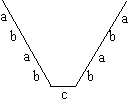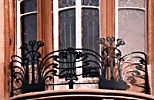Probably the finest art nouveau apartment building in the city.
This building has been erected by and for Lutke & Backes, and hosted their office. That was their best ad. The location (
a street
corner of 65°) offers an additionnal advantage i. e. two facades. If the latter are of yellow sandstone, the framework is of
steel and the inner walls are of reinforced concrete. The floors are connected by an helicoidal stair (with a ellipsoidal section)
whose newel is hollow. There is one flat per floor (300 m
2 ).
The architects gave a more slender appearance to the building by giving an unusual height to each level as it used to be in the
Neustadt: ground-floor + 3 levels + attic.
The bays are arranged symmetrically regarding to the cut-off corner (a-b-a-b-c-a-b-a-b, where "c" refers to the cut-off corner).

The
façades are horizontally animated by alternately flat and convex bays. The architects also played with the
windows either triple (or convex bays), or simple or even twinned (3rd floor), the latter getting under the cornice a
tulip-patterned
frieze.
Also to be noted: the fire-pots on either side of the cornice bays.
The corner's façade is also of great interest. Covered with an oriel supported by consoles, these ones are continued by a smooth
wall surrounding a window adorned with stained glass at the first floor, than give way to fluted pilasters that turn into columns,
which amortize in a bunch before standing a
glass awning. Don't forget to look at the side windows of the oriel: they are convex.
The
façade on the rue du Maréchal Foch gave onto a front yard closed with wrought iron all in curves and counter-curves.
The entrance
door plays with the "
femme-fleur"
i. e. women-flower's theme.
The vestibule is halfway covered with lotus-patterned tiles.
The stairway is lightened with wonderful stained-glass windows showing a landscape.
The interest of the architects in any detail can also be remarked on the landing doors, the handles, the wainscoting in the
apartments, the radiators, the ceilings.
The decorative choices witness diverse influences:
- french (glass awning)
- at the same time french and german
(1) (
sculpture above the entrance door),
- belgian, especially Horta (
moulding).









 (1) If the straight face, witnesses the influence of the "Jugendstil" (german art nouveau ), the hair, on the contrary is wavy,giving a sensual allure, which is representative of the french "femme-fleur", so typical to the french art nouveau. That sculpture is indeed representative to the conjunction of german and latin influences, which brought to the alsatian identity.
(1) If the straight face, witnesses the influence of the "Jugendstil" (german art nouveau ), the hair, on the contrary is wavy,giving a sensual allure, which is representative of the french "femme-fleur", so typical to the french art nouveau. That sculpture is indeed representative to the conjunction of german and latin influences, which brought to the alsatian identity.









